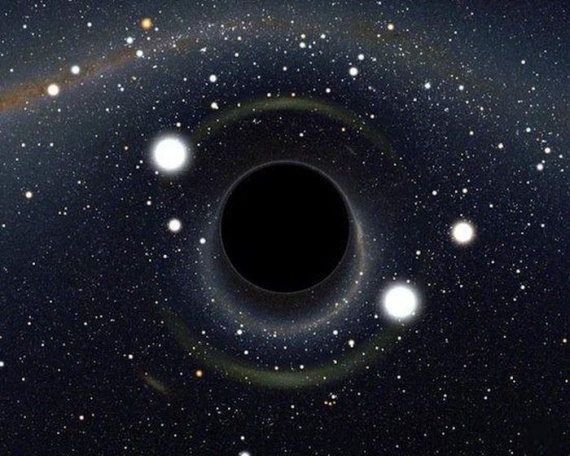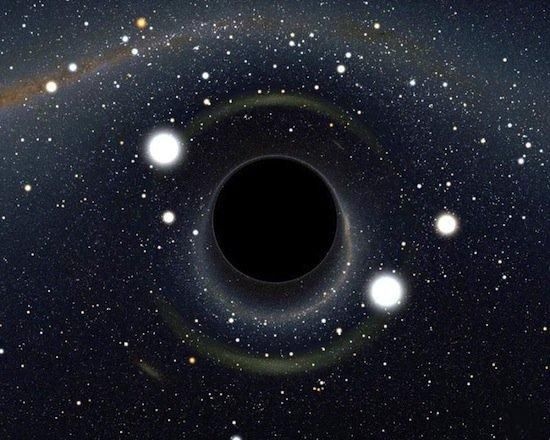1627
5 most staggering things that science has learned to do (5 photos)
We hear about the new wonders of science literally every day for a long time and are used to it. We have not much can surprise. And yet ... sometimes what happens in laboratories very much like black magic. For example:

1. To penetrate into your imagination and write them

The stranger who breaks into your dreams and watches the most intimate fantasies - it sounds very unscientific. Natural magic. Yes, we've all heard about the electrical signals that come from the brain, and that it is theoretically possible to capture and decode.
But ... this is our dream. The parallel world in which we fly on dragons and get Oscars. You can not connect to this our internal broadcasting and watch cable TV.
It turns out you can.
Researchers at the University of California at Berkeley and found a way to really see what the brain sees. They are connected to the heads of the participants of the experiment the electrodes with which recorded brain activity and began to show them the trailer from YouTube - a huge number of trailers all sorts of different films.
Then they loaded into a computer, and those same trailers to put the machine problem: millions of film frames to compare images obtained with the instrument, fixing activity of the brain and bind various changes in brain activity with a variety of images.
Eventually, they began to leave the image of "what the brain sees" - until, of course, is not very clear, but still impressive:
Of course, there is more work to do, but the main thing - the idea was correct. Imagery can actually be recorded on video. It remains only to perfect the process of recording, and you can not strain to write posts and to spread the idea straight to YouTube.
And for those who still do not want to part with the habit to make out his thoughts in the form of text, a team of scientists from the Netherlands invented a system to print just thinking about the letter you want - and the system is running, even if the user is in a coma.
They found - if a person is in a "vegetative" state asked to imagine that he, say, playing tennis, then certain areas of the brain are activated. Further remains to train the patient to associate different letters on the keyboard with a certain way, and using the appropriate tools to determine the more active areas of the brain. And yet. You can write a novel.
2. The speed of light is slowed down to the speed of movement of public transport

"The speed of light," as we know - is constant. This means that it does not change. Never. It is literally the speed limiter, operating in the universe.
The light from the lantern fly to the wall at a speed of 186,282 miles per second (or (3? 108 m / s approx. mixstuff.ru/ ) and according to the laws of physics will do can not fly. But what if the light slowed down to, for example, 60 kilometers per hour? What if a disaster? Even if not, it would be interesting to overtake cars the light from the headlights of his own.
Amazingly, the scientists managed to slow indeed a ray of light to the speed of urban transport.
It turns out that the assertion that the "speed of light" - the fastest that exists in the universe, is not quite true. That is to reach the opposite wall will light a torch really can not do anything - because there is no light weight. But the trick is that light, like everything else, is composed of particles, and these particles can theoretically slow down or even stop altogether.
And not only in theory. Danish physicist Lin Howe found a way to slow light by passing it through a cloud of ultra-cold sodium atoms. This is about how to skip a bullet through the water obstacle.
What to do with all this on, Lin does not know. But anyone anything necessarily up.
3. Teleportatsiya information

That does not sound very impressive - in a sense, information is now transmitted instantaneously. Mobile phones, the Internet, far too quickly?
It's not about that. When we talk on the phone, then send radio waves in the air, and they must make their way from one place to another. Therefore, if you are in Russia and call anywhere in Australia, there is a delay. And then, the waves can be blocked in different ways.
It's about learning how to transfer information from one place to another is not fast - instantly, without any intermediaries. It appears possible that.
In 2009, scientists from the University of Maryland teleported information from one atom to another over a distance of one meter. And in 2012, the same as the Chinese have done - only at a distance of 60 miles (96, 5 km.).
Nothing to do with a quick movement was not there. In general, the movement had nothing to do. The signal just happened to be in a different place and that's it.
This phenomenon is called "quantum entanglement." The two "related" to each other atom can be separated and diluted in different directions for many kilometers, but (that's the whole point) if one of them there will be some changes, it is immediately affect the other. They can not convey information, they are simply "bound" forces that people comprehend not yet able to.
4. Black holes

When the star becomes very, very big, it becomes fantastically strong attraction, it begins to draw everything, even light ...
Because of this, it's not very scientific explanation, you can understand why the formation of black holes here on Earth, it is impossible. We just did not find anything big enough to hold the light.
Although the Chinese have happened - in 2009. And as you can see, they survived.
In fact, Chinese scientists have found a way to mimic what does a black hole - and dispensed with heavyweight stars in the laboratory.
They created a "black hole" in miniature using 60 concentric rings of metamaterials (class of composite materials that can distort light and other waves). Ring is disposed in concentric layers, and each layer is absorbed (or absorbed) by specific wavelengths of electromagnetic waves.
We will not bore readers technical details, except to say that the result was almost the same effect as when light passes through a black hole - he stuck once got inside.
While the experiment was carried out only with the microwave waves, but scientists hope to soon repeat the same experience and with visible light. And it's not just a scientific curiosity. This discovery may completely change the approach to the "collection" of solar energy. Bulky mirror will soon become yesterday's day - a small black hole could suck in the sunlight like a vacuum cleaner.
5. Creating a matter of personal

One of the most fundamental rules of the universe states that "nothing will come of nothing" - if you are not a magician, of course. But there are scientists, which the word "impossible" is particularly inspiring. "While we have lasers, nothing is impossible" - sure they are.
In the late '90s, scientists used the Stanford Accelerator Laboratory (it's older sister the Large Hadron Collider) to repeat one of the tricks of David Copperfield - the material to create something out of nothing. Only without cheating.
The fact that the vacuum - is not quite complete void. This connection of matter and antimatter - particles and antiparticles. And although their density is just incredibly high, neither see nor hear nor touch them, we can not - all due to the fact that they are completely reduced to nothing of each other. That is, the vacuum is actually full of energy, it somehow and should be converted into matter.
To do this, scientists have made a kind of "Bang in reverse" - that is, instead of converting mass into energy, they began to irradiate the laser energy is not out of it get a lot.
Lasers used for this super-power - the power of only one of them reached a trillion watts. It's like 16 billion of conventional bulbs. And yet to get a couple of electrons.
Not much of course, but Down and Out the trouble started.
Source: mixstuff.ru

1. To penetrate into your imagination and write them

The stranger who breaks into your dreams and watches the most intimate fantasies - it sounds very unscientific. Natural magic. Yes, we've all heard about the electrical signals that come from the brain, and that it is theoretically possible to capture and decode.
But ... this is our dream. The parallel world in which we fly on dragons and get Oscars. You can not connect to this our internal broadcasting and watch cable TV.
It turns out you can.
Researchers at the University of California at Berkeley and found a way to really see what the brain sees. They are connected to the heads of the participants of the experiment the electrodes with which recorded brain activity and began to show them the trailer from YouTube - a huge number of trailers all sorts of different films.
Then they loaded into a computer, and those same trailers to put the machine problem: millions of film frames to compare images obtained with the instrument, fixing activity of the brain and bind various changes in brain activity with a variety of images.
Eventually, they began to leave the image of "what the brain sees" - until, of course, is not very clear, but still impressive:
Of course, there is more work to do, but the main thing - the idea was correct. Imagery can actually be recorded on video. It remains only to perfect the process of recording, and you can not strain to write posts and to spread the idea straight to YouTube.
And for those who still do not want to part with the habit to make out his thoughts in the form of text, a team of scientists from the Netherlands invented a system to print just thinking about the letter you want - and the system is running, even if the user is in a coma.
They found - if a person is in a "vegetative" state asked to imagine that he, say, playing tennis, then certain areas of the brain are activated. Further remains to train the patient to associate different letters on the keyboard with a certain way, and using the appropriate tools to determine the more active areas of the brain. And yet. You can write a novel.
2. The speed of light is slowed down to the speed of movement of public transport

"The speed of light," as we know - is constant. This means that it does not change. Never. It is literally the speed limiter, operating in the universe.
The light from the lantern fly to the wall at a speed of 186,282 miles per second (or (3? 108 m / s approx. mixstuff.ru/ ) and according to the laws of physics will do can not fly. But what if the light slowed down to, for example, 60 kilometers per hour? What if a disaster? Even if not, it would be interesting to overtake cars the light from the headlights of his own.
Amazingly, the scientists managed to slow indeed a ray of light to the speed of urban transport.
It turns out that the assertion that the "speed of light" - the fastest that exists in the universe, is not quite true. That is to reach the opposite wall will light a torch really can not do anything - because there is no light weight. But the trick is that light, like everything else, is composed of particles, and these particles can theoretically slow down or even stop altogether.
And not only in theory. Danish physicist Lin Howe found a way to slow light by passing it through a cloud of ultra-cold sodium atoms. This is about how to skip a bullet through the water obstacle.
What to do with all this on, Lin does not know. But anyone anything necessarily up.
3. Teleportatsiya information

That does not sound very impressive - in a sense, information is now transmitted instantaneously. Mobile phones, the Internet, far too quickly?
It's not about that. When we talk on the phone, then send radio waves in the air, and they must make their way from one place to another. Therefore, if you are in Russia and call anywhere in Australia, there is a delay. And then, the waves can be blocked in different ways.
It's about learning how to transfer information from one place to another is not fast - instantly, without any intermediaries. It appears possible that.
In 2009, scientists from the University of Maryland teleported information from one atom to another over a distance of one meter. And in 2012, the same as the Chinese have done - only at a distance of 60 miles (96, 5 km.).
Nothing to do with a quick movement was not there. In general, the movement had nothing to do. The signal just happened to be in a different place and that's it.
This phenomenon is called "quantum entanglement." The two "related" to each other atom can be separated and diluted in different directions for many kilometers, but (that's the whole point) if one of them there will be some changes, it is immediately affect the other. They can not convey information, they are simply "bound" forces that people comprehend not yet able to.
4. Black holes

When the star becomes very, very big, it becomes fantastically strong attraction, it begins to draw everything, even light ...
Because of this, it's not very scientific explanation, you can understand why the formation of black holes here on Earth, it is impossible. We just did not find anything big enough to hold the light.
Although the Chinese have happened - in 2009. And as you can see, they survived.
In fact, Chinese scientists have found a way to mimic what does a black hole - and dispensed with heavyweight stars in the laboratory.
They created a "black hole" in miniature using 60 concentric rings of metamaterials (class of composite materials that can distort light and other waves). Ring is disposed in concentric layers, and each layer is absorbed (or absorbed) by specific wavelengths of electromagnetic waves.
We will not bore readers technical details, except to say that the result was almost the same effect as when light passes through a black hole - he stuck once got inside.
While the experiment was carried out only with the microwave waves, but scientists hope to soon repeat the same experience and with visible light. And it's not just a scientific curiosity. This discovery may completely change the approach to the "collection" of solar energy. Bulky mirror will soon become yesterday's day - a small black hole could suck in the sunlight like a vacuum cleaner.
5. Creating a matter of personal

One of the most fundamental rules of the universe states that "nothing will come of nothing" - if you are not a magician, of course. But there are scientists, which the word "impossible" is particularly inspiring. "While we have lasers, nothing is impossible" - sure they are.
In the late '90s, scientists used the Stanford Accelerator Laboratory (it's older sister the Large Hadron Collider) to repeat one of the tricks of David Copperfield - the material to create something out of nothing. Only without cheating.
The fact that the vacuum - is not quite complete void. This connection of matter and antimatter - particles and antiparticles. And although their density is just incredibly high, neither see nor hear nor touch them, we can not - all due to the fact that they are completely reduced to nothing of each other. That is, the vacuum is actually full of energy, it somehow and should be converted into matter.
To do this, scientists have made a kind of "Bang in reverse" - that is, instead of converting mass into energy, they began to irradiate the laser energy is not out of it get a lot.
Lasers used for this super-power - the power of only one of them reached a trillion watts. It's like 16 billion of conventional bulbs. And yet to get a couple of electrons.
Not much of course, but Down and Out the trouble started.
Source: mixstuff.ru























